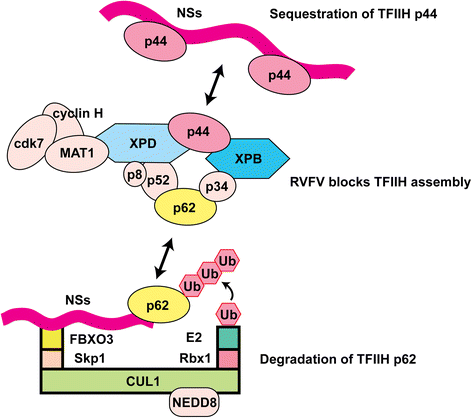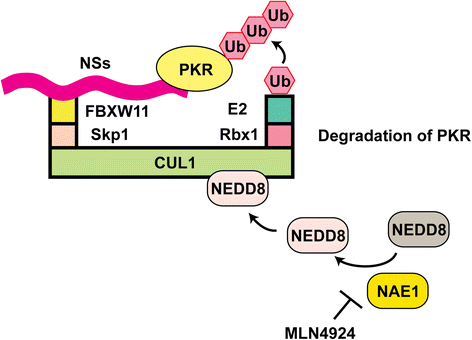Rift Valley fever virus NSs protein functions and the similarity to other bunyavirus NSs proteins
- PMID: 27368371
- PMCID: PMC4930582
- DOI: 10.1186/s12985-016-0573-8
Rift Valley fever virus NSs protein functions and the similarity to other bunyavirus NSs proteins
Abstract
Rift Valley fever is a mosquito-borne zoonotic disease that affects both ruminants and humans. The nonstructural (NS) protein, which is a major virulence factor for Rift Valley fever virus (RVFV), is encoded on the S-segment. Through the cullin 1-Skp1-Fbox E3 ligase complex, the NSs protein promotes the degradation of at least two host proteins, the TFIIH p62 and the PKR proteins. NSs protein bridges the Fbox protein with subsequent substrates, and facilitates the transfer of ubiquitin. The SAP30-YY1 complex also bridges the NSs protein with chromatin DNA, affecting cohesion and segregation of chromatin DNA as well as the activation of interferon-β promoter. The presence of NSs filaments in the nucleus induces DNA damage responses and causes cell-cycle arrest, p53 activation, and apoptosis. Despite the fact that NSs proteins have poor amino acid similarity among bunyaviruses, the strategy utilized to hijack host cells are similar. This review will provide and summarize an update of recent findings pertaining to the biological functions of the NSs protein of RVFV as well as the differences from those of other bunyaviruses.
Keywords: Bunyavirus; E3 ligase; Interferon; NSs; PKR; Phlebovirus; Rift Valley fever virus; TFIIH; Ubiquitin; p53; p62.
Figures



References
-
- Daubney R, Hudson JR. Enzootic hepatitis or Rift Valley fever: An undescribed virus disease of sheep cattle and man from east Africa. J Pathol Bacteriol. 1931;34:545–579. doi: 10.1002/path.1700340418. - DOI
-
- Swanepoel R, Coetzer JAW. Rift Valley fever. In: Coetzer JAW, Tustin RC, editors. Infectious diseases of livestock with special reference to southern Africa. 2. Cape Town: Oxford University Press; 2004. pp. 1037–1070.
-
- Carroll SA, Reynes JM, Khristova ML, Andriamandimby SF, Rollin PE, Nichol ST. Genetic evidence for Rift Valley fever outbreaks in Madagascar resulting from virus introductions from the East African mainland rather than enzootic maintenance. J Virol. 2011;85:6162–6167. doi: 10.1128/JVI.00335-11. - DOI - PMC - PubMed
Publication types
MeSH terms
Substances
Grants and funding
LinkOut - more resources
Full Text Sources
Other Literature Sources
Research Materials
Miscellaneous

